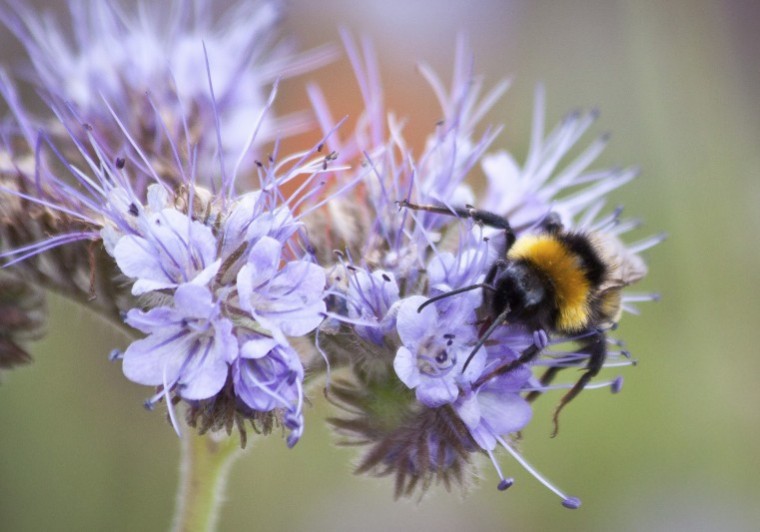The English Mustard Growers (EMG), a farm collective based in Cambridgeshire, Lincolnshire and Norfolk which supply seed to the Colman’s English Mustard brand, are working in partnership with crop production specialists, Hutchinsons, to map the availability of nectar and pollen throughout the year.
The aim of the project is to ensure pollinators, such a honey bees, receive a steady supply of food resources, which will in turn support crop yields. The ten year project, which began in 2014, is the biggest of its kind in the UK, covering a total of 10,000 hectares of land, and is fully supported by the British Beekeepers Association. (BBKA)
Now two years into the project the EMG have been busy growing a variety of plant species, including bulbs, shrubs, hedges and wild flowers across their farmland, to ensure pollinators have enough nectar and pollen supply before hibernation at the end of autumn. Autumn and spring months are crucial for the survival of honey bees as this is when nectar and pollen supply is at its lowest.
In a bid to enhance nectar and pollen supply, the farmers participating in the project have planted a total of 21,000 flowering bulbs within their hedgerows, ditches and field margins. One of the participating farms has also planted over 500 native hedge species and plans to grow over 200 shrubs a year to re-generate the surrounding woodland.
This comes after survey results revealed the importance of hedges and shrubs to nectar and pollen supply as well as being safe places for bees to breed and escape predators. Over the autumn period, participating farms intend to grow over 13 hectares of flower rich margins and 3.5 hectares of pollen and nectar mix plants which will provide bees will a supply of food throughout next spring and summer.
The project has also importantly inspired farmers to work collectively to connect their land to create extensive wildlife corridors. To date, a total of 85 kilometres of hedgerows and just over 380 kilometres of grass margins, in which many of the new plant varieties are being grown, have been established. This is the equivalent distance of over two laps on the M25. The longer term ambition of the project is to help protect pollinator populations and boost the broader biodiversity within the region.
In addition to maintaining and eventually improving pollinator populations, the project will also help protect crop yields and boost British agriculture. Michael Sly, chairman of the English Mustard Growers explains: “One of our mustard varieties, White Mustard (Gedney), depends entirely on pollinators, such as bees, for its pollination during flowering time. This, coupled with the significant role bees play in our wider ecosystem, makes this a particularly important area for us to support.”
Delving further into the science behind the project, each of the participating farms underwent a detailed survey in which a botanist calculated the total amount of pollen and nectar available in crops, hedgerows, woodland and field margins. The data was then used to estimate the amount of pollen and nectar produced by different types of plant species on a month by month basis.
Mike Hutchinson, director of Hutchinsons crop production specialists, who conducted and analysed the initial survey, and will continue to advise growers for the duration of the project said: “By mapping the availability of pollen and nectar on individual farms on a monthly basis, each farmer can identify where the availability gaps are – usually during early spring and late autumn – and can take measures to enhance supply during these times. Solutions can include changing cutting regimes on grass and flower margins or building diversity into crop production. The aspect which makes this project effective and unique is its scale and ability to monitor nectar and pollen supplies on a month-by-month basis.”
The collaborative project is an example of how agricultural suppliers, expert advisors and farmers can work together to benefit biodiversity and secure the continuous supply of vital crops.
On-farm practices to increase pollinator populations
Many pollinating insects have become reliant on a narrow range of arable crops, notably oilseed rape and beans, for their nectar supply and it is crucial to build more diversity into this supply throughout the year, not just the main summer months through stewardship schemes and other measures – and this project is all about fine tuning and improving some of the things that are already in place.
Mr Hutchinson acknowledges that it may be difficult and potentially quite costly to establish purpose-bought herbaceous seed early in the season, so instead suggests trying to identify and encourage naturally-occurring beneficial plants on certain uncropped areas, field margins or awkward field corners.
“For example, ground ivy, white/ red deadnettle and dandelion are all useful species for extending insect food availability, while planting early flowering shrubby species such as goat willow and blackthorn can give longer-term benefits.”
“Changing cutting regimes on grass and flower margins to delay flowering is another relatively easy way to extend food supply for insects, while including late-flowering species like knapweed in any mix is a useful addition for boosting end of season food” he says. “There are also a number of other wild species that flower later in the year, such as field scabious and wild carrot.”
He adds that all of these measures are designed to be practical, achievable and fit in with the specific landscape of the farm. “We sometimes see land being taken out of food production with the noble intention of providing habitat for pollinators. However, it isn’t until one analyses the entire landscape that it becomes evident that the changes being made are not necessarily having the desired effects.”




